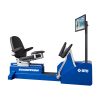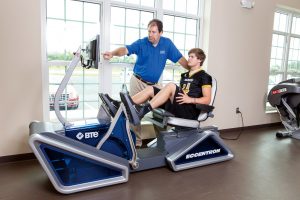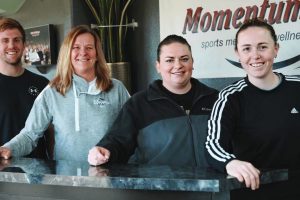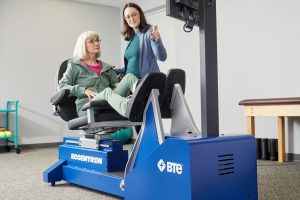
Knee Osteoarthritis and Eccentrics Clinical Trial: Decrease Pain, Increase Strength and Function with Eccentron
Case Studies“Eccentric exercise has the unique capability to generate the highest muscle force, and patients can grow stronger at the highest possible rate compared to other exercise,” says Michael Bade, PT, DPT, PhD.
Knee osteoarthritis is the most common type of arthritis, particularly among older adults. It affects 40% of adults older than 70 years.1 As our patients age, they become more at risk for developing knee osteoarthritis from normal wear and tear or cartilage degeneration.1 Among the best physical therapy treatments for knee OA, Eccentron’s research-backed eccentric exercise protocol is highly safe and effective for elderly patients.
According to a recent clinical trial, knee osteoarthritis patients saw major improvements in strength, TUG, sit-to-stand, and pain relief after eccentric-focused physical therapy.2 Participants in this knee osteoarthritis treatment program used the Eccentron twice per week for eight weeks and experienced remarkable results.
In this article, we’ll take a closer look at why eccentrics works for knee osteoarthritis, how to isolate eccentric exercise, and the knee OA clinical trial using Eccentron. Let’s dive in!
What is the Eccentron?
The Eccentron is an eccentric-only lower extremity exercise system by BTE. Based on decades of research and development, it is the world’s only physical therapy equipment that isolates eccentric contractions of the leg. Capable of both assessment and treatment, the Eccentron tracks patient progress over time with objective measurement and provides data-driven dosing. With the instant visual feedback and fun game mode, patients love coming back for session after session.
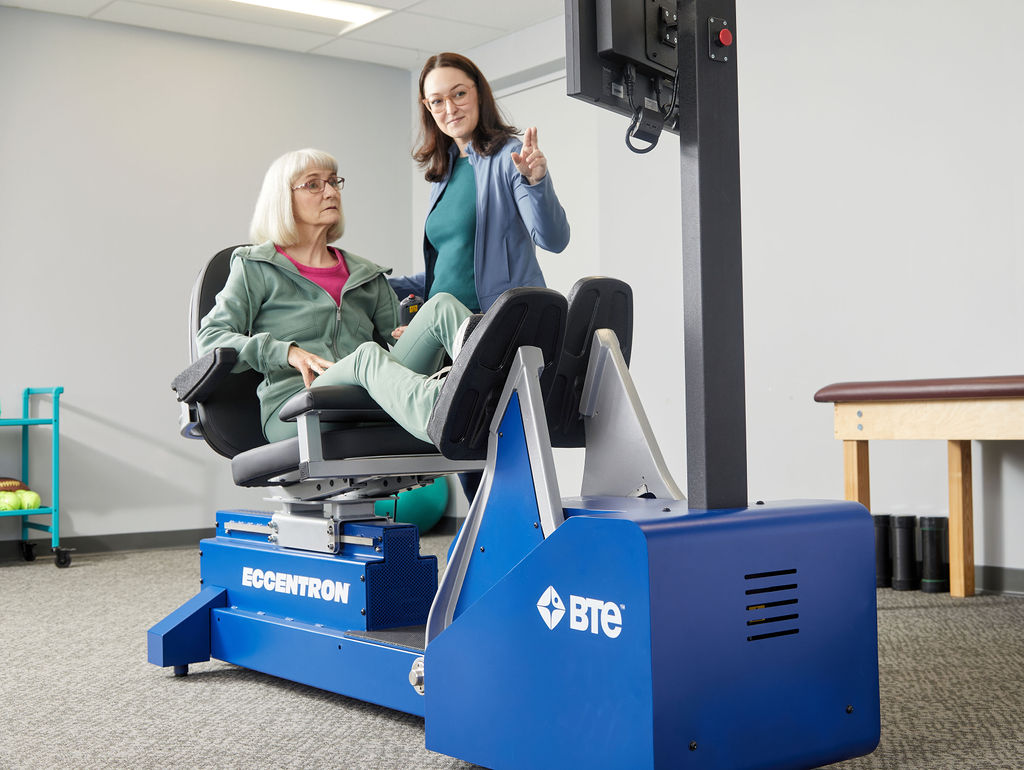
Why Eccentric Exercise for Knee Osteoarthritis?
“Eccentric exercise has the unique capability to generate the highest muscle force, and patients can grow stronger at the highest possible rate compared to other exercise,” says Michael Bade, PT, DPT, PhD. Dr. Bade is an Associate Professor at the Regis University School of Physical Therapy, nationally ranked in the top 15% of physical therapy programs.
In a previous article, we dove into all the whys and hows of eccentric exercise for injury recovery. See: The PT’s Ultimate Guide to Eccentric Training: ACL, Fall Prevention, Neuromuscular Control, and More.
Specifically for knee osteoarthritis, eccentric exercise offers unique benefits that you wouldn’t be able to leverage with concentric exercise alone. First, it’s less demanding on patients’ energy and cardiopulmonary systems.3 The energetic cost of eccentric exercise is about four times lower than concentric.4 This means your elderly patients can tolerate eccentric exercises more comfortably.
Second, it’s more efficient at activating and building muscle.3 As you know, muscles lengthen during eccentric contractions. This lengthening builds up potential energy in the muscle, then releases in the subsequent concentric action. Thanks to this reclaimed elastic energy, the muscle doesn’t use as much energy. 4 For a more detailed breakdown of the physiology behind eccentrics’ low energetic cost, skip to this section of The PT’s Ultimate Guide to Eccentric Training.
Third, it promotes neural plasticity and neuromuscular control at higher levels than concentric or isometric contractions. 5 This neural component is one of its greatest benefits for physical therapy. As with knee osteoarthritis, people with sensitive joints tend to adopt protective or compensatory movement patterns. These patterns can contribute to prolonged symptoms and risk of re-injury. 6 During rehabilitation, we must help the patient break those habits, correct the movement patterns, and address any resulting imbalances. Recent research suggests that eccentric exercise can retrain neural pathways to prevent pain and reinjury and improve neuromuscular control. 6
How to Isolate Eccentric Contractions for Knee Osteoarthritis Treatment
Your knee osteoarthritis patients are most likely older, experiencing joint pain, and may not have a rigorous exercise background. On top of these factors, elderly patients may likely have a low exercise tolerance when they begin physical therapy sessions. For these reasons, it’s important to start with exercises that are low-demand but still effective and evidence-based.
Most exercises have a concentric and an eccentric phase, but you need to isolate the eccentric contraction in order to leverage those unique benefits mentioned earlier. A recent electromyography (EMG) study compared several eccentric physical therapy exercises and the level of muscle activation.7 These exercises include toe raise, stability ball leg curl, side lift, decline board leg extension, and the Eccentron. During exercise, the EMG measured activation of the quadriceps, gastrocnemius, hip adductors, and hamstring.
According to the study, the Eccentron produced muscle activation almost four times higher than the other exercises for all muscle groups. Participants using the Eccentron achieved an average muscle activation of 60% of their maximum.7 To use the Eccentron, participants were positioned on the system sitting with both feet on the pedals. The pedals alternate and move toward the user with variable force. As the pedal moves in, the user resists with an eccentric contraction, bending the knee to the chest. There is never a concentric or “leg press” movement. This repetition creates an eccentric-only, closed-chain movement like walking down the stairs.
However, unlike descending the stairs, Eccentron can facilitate this movement with less than the patient’s bodyweight. Perfect for sensitive joints like knee osteoarthritis, Eccentron provides an unweighted or partial weightbearing stair descent movement. This early intervention exercise helps patients gradually build strength and confidence before progressing to more challenging resistance levels.
Can Eccentron Treat Knee Osteoarthritis?
Using Eccentron as part of a comprehensive physical therapy program can be very effective at treating knee osteoarthritis. Of course, there isn’t a cure for osteoarthritis, so the best we can do is alleviate patients’ symptoms and slow its progression. Studies show that physical therapy leads to decreased symptoms and improved function for knee osteoarthritis.8
The Eccentron is ideal for early intervention, elderly patients, and those with low tolerance for exercise. Because it facilitates eccentric-only contractions, it’s very gentle yet effective for sensitive joints. As the patient progresses, you can increase the resistance gradually and objectively, based on the Eccentron’s periodic assessments.
After each session, Eccentron provides progress reports showing charts and graphs of your patient’s improvement over time. For your knee osteoarthritis patients, these progress reports can be a powerful motivator. “Many patients in this population think they are destined to degenerate, that they can’t get any better or any stronger. The Eccentron shows them that they are getting stronger,” says Dr. Bade.
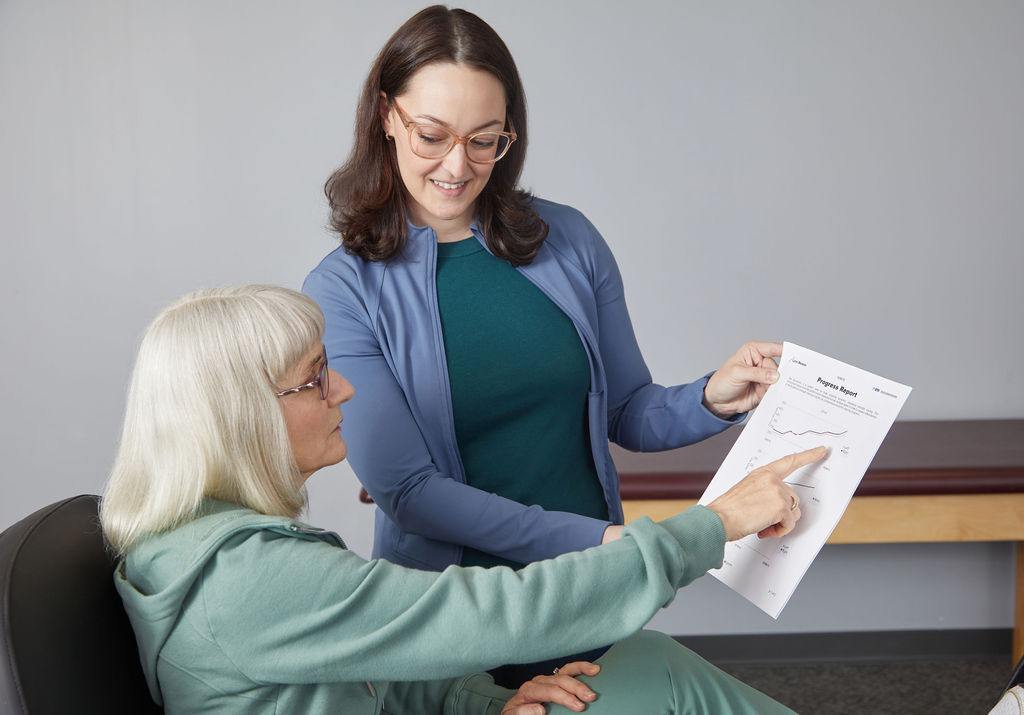
Patients with degenerative conditions like knee osteoarthritis often believe that they’ll never get better. When treating these patients, it’s important to encourage a more optimistic mindset. We can still make a difference with increasing strength, mobility, and functionality. Objective progress reports like the Eccentron’s show concrete proof of progress. This visual feedback helps the patient focus on what they can do, instead of what they can’t.
What Does Clinical Research Show About Eccentron and Knee Osteoarthritis?
A clinical trial at Regis University examined the efficacy of the Eccentron in treating knee osteoarthritis.2 Led by Dr. Bade, the team of researchers designed an eccentric-only exercise protocol with baseline and followup assessments. Study participants completed an eight-week exercise program, using the Eccentron twice per week.2
After using the Eccentron, participants showed remarkable improvements in strength and function. On average, participants saw a 64% increase in hip extensor strength, 40% increase in hip abductor strength, and 16% increase in knee extensor strength. The exercise also produced improvements in gait speed, TUG (timed up-and-go) test, 5x sit-to-stand, and overall knee pain.2
“Some of the best results were the comments from the patients. Things like how they are looking forward to going hiking that weekend or even skiing, or just how nice it is to walk down the stairs without pain.” – Michael Bade, PT, DPT, Ph.D., OCS, COMT, FAAOMPT
Get the full report on the clinical trial of Eccentron for treating knee osteoarthritis below:
Clinically Proven Knee Osteoarthritis Equipment for Your Clinic
Your patients deserve the best. Not only is Eccentron clinically proven to improve strength and function for knee osteoarthritis, but it’s versatile enough for a wide range of patients. From early post-op to high-intensity athletic training, Eccentron accommodates any strength level. With decades of clinical research behind it, Eccentron is an evidence-based intervention for ACL recovery, hip fracture, total knee replacement, stroke, and more. Contact us today for a quote on Eccentron for your rehabilitation clinic.
Colleen Isaiah
TherapySpark Editor
BTE

